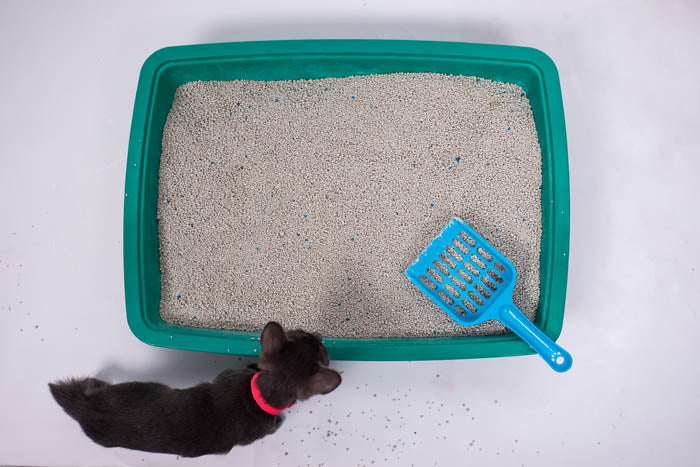
How to dispose of cat litter?
Share
Here you will find the best ways to dispose of cat litter, without harming the environment, your cat and your health.
First let's start by mentioning those things that you should avoid and then we'll review each one of the options on properly disposing of your cat's litter, with the involved elements, your kitty's urine and poop.
Should “AVOID”:
AVOID USING CLAY CAT LITTER: Almost all type of bentonite clay litter is obtained by strip mining. This type of mining eventually produces pits from which minerals are extracted and a huge pile of discarded matter, plus it's not biodegradable. Another important fact is that clay litter can't be composted, unless you are sure that your compost bin is heating over 145 F.So, if you want to do your planet a favor, diminish your cat’s impact on the environment. Planet Earth will be grateful to you!
AVOID FLUSHING YOUR CAT'S LITTER DOWN THE TOILET: By doing this, it will cause to backup your toilet drains and when the litter is "clumpable", it can even block up your sewer, which will eventually wreak serious havoc on your septic system. Even some litters labeled as "flushable" should not be sent through the toilet. By flushing litter, you are also sending dangerous parasites that may be living in your cat's poop, all the way to the sea. This parasite is called Toxoplasma Gondii which produces toxoplasmosis, a disease that results from an infection caused by the mentioned parasite.Based on a study performed by UC Davis and the California Department of Fish and Game, were found 62% of dead otters from the California sea, to be infected by this parasite which caused lethal brain inflammation.
Let's support our marine life and save some cute otters!
AVOID BUYING AND USING REGULAR PLASTIC BAGS: Our planet is suffering a lot and it’s time to lend it a hand by “REUSING” bags, it’s very simple and it’s explained below on the “Should DO” list.This is another way to help our ecosystem and you will save some money too!
AVOID LEAVING YOUR CAT'S FECES OUTDOORS: It's important to clarify that the word ”outdoors” here is related to the “streets” and not an ornamental garden. Please keep in mind that if your cat poops on the streets, you should bag the waste and throw it with the rest of your trash. When cat poop is left on the street, it's more likely that this waste will be washed by the rain through the water system, and eventually it will reach the sea.As you read before, this will harm our marine life and we should prevent this from happening.
AVOID USING LITTER BOX LINERS: Even though these boxes are 100% biodegradable, made with recycled paper, they’re still unnecessary waste. There is no point and it’s not good for our environment to toss and to keep replacing litter box liners when you can use a bamboo or even a plastic litter box that will last for a good amount of time.You can keep using your current litter box or if it's too old, and doesn't work anymore, get one made from a long lasting material.
What should you DO then?
Should “DO” - ECO-FRIENDLY IDEAS:
USE BIODEGRADABLE CAT LITTER: There are many in the market today and you can choose from wood, corn, wheat, newspaper, pine cobble, coconut and grass seed.If you don't know which one your cat likes best or which one is more convenient for your home, do some tests first, before deciding on just one.
COMPOST - IDEALLY - IF YOU KNOW HOW TO DO IT AND HAVE THE TIME: Make sure that your compost reaches 145 degrees F in order to ensure that any pathogens are killed in the process. Compost is mainly used to grow edible plants that will be consumed by humans, so it's very important that the right procedure is followed, in order to produce adequate compost.If you don't have the time to learn and generate your own compost, there are other options available.
REUSE BAGS: Reuse any bags that you commonly use such as cereal, tortilla chip, pasta, cracker bags, dishwasher soap, etc that will be sent to the landfill anyway. Collect these bags and put them in a bigger bag near the area where your cat litter box is, to keep it organized and handy. Put your cat's poop inside one of those bags, and then place it inside a trash bin with a tight lid and keep it closed.You can even reuse coffee bags as the coffee beans odor helps dilute cat’s poop smell. Once you need to discard all your kitty's poop from the trash bin, take the bags out and put them inside your bigger, regular trash bag, where the rest of the house's waste is.
USE BIODEGRADABLE BAGS - IF YOU ARE STILL IN THE PROCESS OF TRANSITIONING INTO THE “REUSE” habit: Use paper towel and get your cat’s poop and dirty litter and throw it inside a biodegradable bag. Then, add the bags with the cat’s waste and put them inside the large trash bag that you regularly use.It is not the ideal way to dispose of your cat's litter, but it is well recommended and has less impact on our environment.
EMPTY YOUR CAT'S LITTER INTO NEWSPAPER (DON'T THROW YOUR NEWSPAPERS AWAY!): Most of the time, we usually change our cat's litter every 30 days, so this is what you can do. Instead of tossing everything inside biodegradable bags, you can empty your cat's litter on a newspaper, wrap it up and throw it in your trash container.It will eventually mix up with the rest of the house’s waste, and it will better help with the degrading process. Plus, you’ll be “reusing” and giving an additional purpose to your newspapers, rather than just throwing them away.
USE CAT BIODEGRADABLE LITTER AS MULCH FOR A DECORATIVE GARDEN (NOT AN EDIBLE PLANTS GARDEN)This is another option to get rid of your cat's litter, which is also eco-friendly. Take note that you can do this if the litter is biodegradable such as the ones made of wheat, corn, wood, grass seeds, paper, etc. If you have a decorative garden or a dirt spot or some plant pots, you can bury your biodegradable cat litter, along with the cat’s feces and urine, and use it as a natural fertilizer. Your cat’s waste will degrade within the soil.
Please remember that under no circumstance you can use biodegradable cat's litter in a vegetable garden. It would be dangerous for any person who will consume those veggies, due to the parasite Toxoplasma Gondii that was mentioned before.
Based on the options we offer here, choose the one that best suits your beloved cat and your lifestyle. All these recommendations are duly based on hygiene and health measures for you, for your furries and to help our environment.
